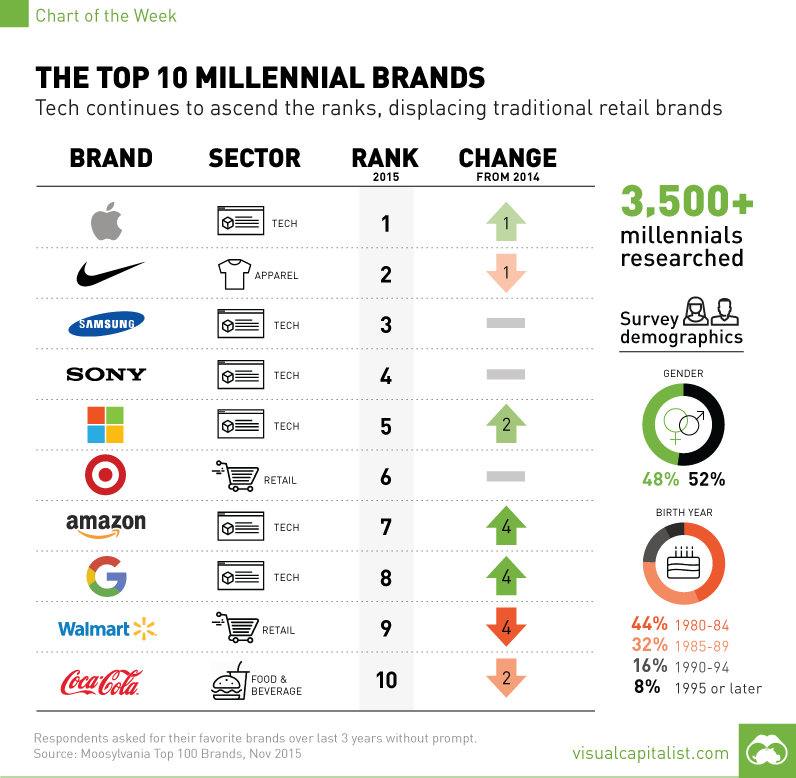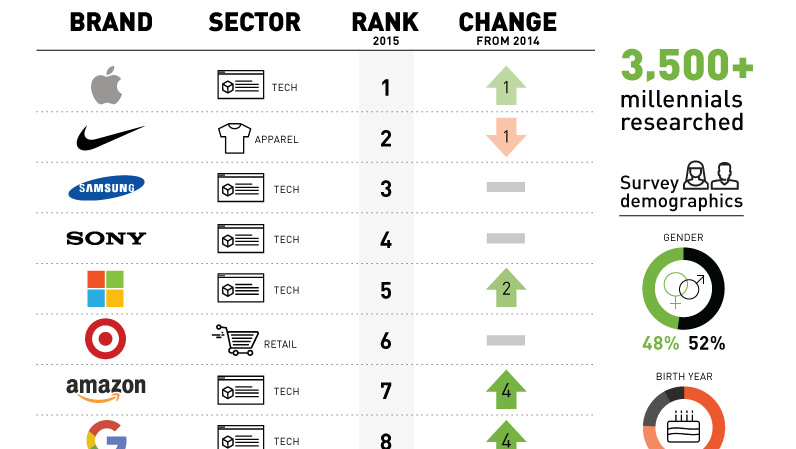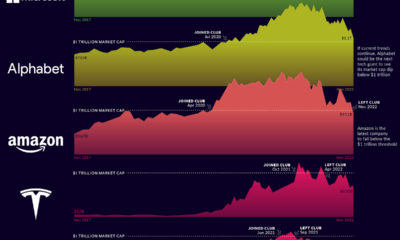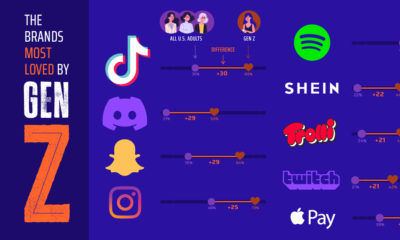The Top 10 Millennial Brands [Charts]
Tech continues to ascend the ranks, displacing traditional retail brands
The Chart of the Week is a weekly Visual Capitalist feature on Fridays. The market for U.S. millennials is expected to blossom to $1.4 trillion by 2020, according to international consulting firm Accenture. While this generation of digital natives is already a primary marketing target today, in the upcoming years millennials will make up a hefty 30% of all retail spending in the country. However, millennials are complex and notoriously difficult to read, even for professional marketers. With values that seem to contradict one another, it’s a challenge for companies to successfully gain market share with this audience. As millennials mature, researchers are gaining ground on the needs and wants of this generation. This week’s Chart of the Week shares data from a comprehensive survey of 3,500 millennials that were asked, without any prompt, about their favorite brands over the past three years. The results, which can be found in deeper depth here, help give us some insight as to what millennials look for in a brand.
Tech Brand Disparity
It’s likely that no one will be surprised to learn that tech brands are among the best polling for millennials. That said, what did surprise is the lack of showing by other prominent technology brands. Facebook, a company that reaches more than a billion people every day, came in at an extremely disappointing 65th place. That’s behind companies such as LG (20), Dell (28), HP (36), HTC (48), ASUS (52) and eBay (53). It’s even behind dreaded telecom companies like Verizon (61) and AT&T (62). Meanwhile, Twitter, IBM, Intel, Paypal, and LinkedIn didn’t even register on the Top 100 radar. Why are some tech brands rocketing up the rankings, while others are falling flat?
Some, but not others?
According to Moosylvania, the researchers behind the survey, there was a major commonality between the top brands for millennials. They found that millennial cohorts prefer fun and entertaining content to news and information in their social media feeds by a margin of six-to-one. Norty Cohen, CEO of Moosylvania, elaborated on this: Could Facebook be the destroyer of fun, by monetizing people’s news feeds? Are IBM and LinkedIn too “businessy” to poke fun at themselves? Perhaps Paypal is too financial – a damning trait, since not a single Top 100 brand was a bank or financial institution. This may explain why a higher degree of millennials are happy to leave traditional and boring financial institutions in the dust. In a previous chart, we showed 49% of millennials are much more open to engaging tech companies for financial services, while only 16% of people of other generations feel the same. It may also be a problem that rising fintech companies such as Venmo, Lending Club, Nutmeg, and others can solve. on But fast forward to the end of last week, and SVB was shuttered by regulators after a panic-induced bank run. So, how exactly did this happen? We dig in below.
Road to a Bank Run
SVB and its customers generally thrived during the low interest rate era, but as rates rose, SVB found itself more exposed to risk than a typical bank. Even so, at the end of 2022, the bank’s balance sheet showed no cause for alarm.
As well, the bank was viewed positively in a number of places. Most Wall Street analyst ratings were overwhelmingly positive on the bank’s stock, and Forbes had just added the bank to its Financial All-Stars list. Outward signs of trouble emerged on Wednesday, March 8th, when SVB surprised investors with news that the bank needed to raise more than $2 billion to shore up its balance sheet. The reaction from prominent venture capitalists was not positive, with Coatue Management, Union Square Ventures, and Peter Thiel’s Founders Fund moving to limit exposure to the 40-year-old bank. The influence of these firms is believed to have added fuel to the fire, and a bank run ensued. Also influencing decision making was the fact that SVB had the highest percentage of uninsured domestic deposits of all big banks. These totaled nearly $152 billion, or about 97% of all deposits. By the end of the day, customers had tried to withdraw $42 billion in deposits.
What Triggered the SVB Collapse?
While the collapse of SVB took place over the course of 44 hours, its roots trace back to the early pandemic years. In 2021, U.S. venture capital-backed companies raised a record $330 billion—double the amount seen in 2020. At the time, interest rates were at rock-bottom levels to help buoy the economy. Matt Levine sums up the situation well: “When interest rates are low everywhere, a dollar in 20 years is about as good as a dollar today, so a startup whose business model is “we will lose money for a decade building artificial intelligence, and then rake in lots of money in the far future” sounds pretty good. When interest rates are higher, a dollar today is better than a dollar tomorrow, so investors want cash flows. When interest rates were low for a long time, and suddenly become high, all the money that was rushing to your customers is suddenly cut off.” Source: Pitchbook Why is this important? During this time, SVB received billions of dollars from these venture-backed clients. In one year alone, their deposits increased 100%. They took these funds and invested them in longer-term bonds. As a result, this created a dangerous trap as the company expected rates would remain low. During this time, SVB invested in bonds at the top of the market. As interest rates rose higher and bond prices declined, SVB started taking major losses on their long-term bond holdings.
Losses Fueling a Liquidity Crunch
When SVB reported its fourth quarter results in early 2023, Moody’s Investor Service, a credit rating agency took notice. In early March, it said that SVB was at high risk for a downgrade due to its significant unrealized losses. In response, SVB looked to sell $2 billion of its investments at a loss to help boost liquidity for its struggling balance sheet. Soon, more hedge funds and venture investors realized SVB could be on thin ice. Depositors withdrew funds in droves, spurring a liquidity squeeze and prompting California regulators and the FDIC to step in and shut down the bank.
What Happens Now?
While much of SVB’s activity was focused on the tech sector, the bank’s shocking collapse has rattled a financial sector that is already on edge.
The four biggest U.S. banks lost a combined $52 billion the day before the SVB collapse. On Friday, other banking stocks saw double-digit drops, including Signature Bank (-23%), First Republic (-15%), and Silvergate Capital (-11%).
Source: Morningstar Direct. *Represents March 9 data, trading halted on March 10.
When the dust settles, it’s hard to predict the ripple effects that will emerge from this dramatic event. For investors, the Secretary of the Treasury Janet Yellen announced confidence in the banking system remaining resilient, noting that regulators have the proper tools in response to the issue.
But others have seen trouble brewing as far back as 2020 (or earlier) when commercial banking assets were skyrocketing and banks were buying bonds when rates were low.

















